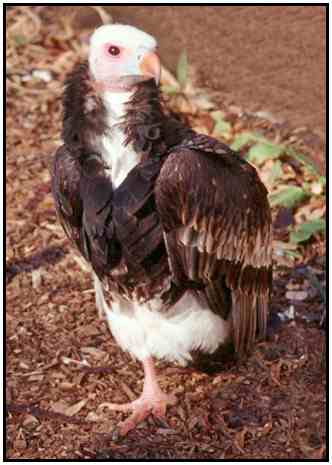White-HeadedOrder: Falconiformes. White-Headed Vultures (Photograph Courtesy of Africam Copyright ©2000)Family: Accipitridae. (Old World vulture). Scientific Name: Trigonoceps occipitalis. Common Names: White-headed Vulture. Conservation Status: Rare. Much less numerous than other African vultures. Rescue & Recovery: Captive breeding. Geographical Range: Widely distributed throughout central Africa, Senegal, Nubia and Somalia. Not found in Arabia. Habitat: Savannahs and steppes, usually in small flocks of about ten birds. It prefers drier areas with tall tress which serve as safe resting places, but there is usually a water supply close by as this birds needs to drink often. Physical Characteristics: The most colourful of the Old World vultures and a substantial bird with a wingspan of two metres. It's most distinguishing feature is a crest of white and along with this it has a pinkish beak and blue cere. The naked parts of the head are quite pale, but turn red when the bird becomes excited. The plumage of the back and collar is a chocolate brown and the tail black. Lower back and legs are white.
White-Headed Vulture (Photograph Courtesy of John White Copyright ©2000)As is typical of most vultures, the White-headed Vulture is to all intents and purposes voiceless, with the syrinx, which gives the nightingale its lovely song, being hardly developed. It will sometimes produce a rather weird, hoarse cry. Notable for being a more aggressive species than other vultures, it seems to retain some of the habits of the eagles from which vultures probably descended. In young birds the entire body is dark, with the exception of the top of the head and the lower neck, which are white. Food: Leads a double life as both scavenger and predator. Hunts small vertebrates, setting out early in the morning searching for carcasses, locusts, or swarming termites. Is quite a skilled hunter in its own right and will even take birds, the young calves of small antelope, flamingo or guinea fowl. These are very solitary birds and even at a carcass it is very unusual to see more than a handful gathered around to feed.
White-Headed Vulture (Photograph Courtesy of John White Copyright ©2000)Reproduction: Nests in tall trees (usually the acacia or the giant baobab), building the nest from grass, scraps and hair until it reaches around 120 centimetres across. A single white or brown and grey spotted egg is laid, then incubated by the female for 43 days. Both parents feed the young by regurgitating food from the crop until the immature vulture leaves the nest three months later. Thumbnails (Click For Full-Size Image):
|




